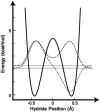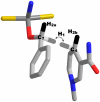Elusive transition state of alcohol dehydrogenase unveiled
- PMID: 20457944
- PMCID: PMC2906880
- DOI: 10.1073/pnas.1000931107
Elusive transition state of alcohol dehydrogenase unveiled
Abstract
For several decades the hydride transfer catalyzed by alcohol dehydrogenase has been difficult to understand. Here we add to the large corpus of anomalous and paradoxical data collected for this reaction by measuring a normal (> 1) 2 degrees kinetic isotope effect (KIE) for the reduction of benzaldehyde. Because the relevant equilibrium effect is inverse (< 1), this KIE eludes the traditional interpretation of 2 degrees KIEs. It does, however, enable the development of a comprehensive model for the "tunneling ready state" (TRS) of the reaction that fits into the general scheme of Marcus-like models of hydrogen tunneling. The TRS is the ensemble of states along the intricate reorganization coordinate, where H tunneling between the donor and acceptor occurs (the crossing point in Marcus theory). It is comparable to the effective transition state implied by ensemble-averaged variational transition state theory. Properties of the TRS are approximated as an average of the individual properties of the donor and acceptor states. The model is consistent with experimental findings that previously appeared contradictory; specifically, it resolves the long-standing ambiguity regarding the location of the TRS (aldehyde-like vs. alcohol-like). The new picture of the TRS for this reaction identifies the principal components of the collective reaction coordinate and the average structure of the saddle point along that coordinate.
Conflict of interest statement
The authors declare no conflict of interest.
Figures






Similar articles
-
Use of pH studies to determine the kinetic and chemical mechanism of yeast alcohol dehydrogenase with primary aliphatic alcohols and aldehydes.Indian J Biochem Biophys. 1996 Jun;33(3):177-83. Indian J Biochem Biophys. 1996. PMID: 8828287
-
A critical test of the "tunneling and coupled motion" concept in enzymatic alcohol oxidation.J Am Chem Soc. 2013 Sep 18;135(37):13624-7. doi: 10.1021/ja405917m. Epub 2013 Sep 10. J Am Chem Soc. 2013. PMID: 24020836 Free PMC article.
-
Mechanism of aldehyde oxidation catalyzed by horse liver alcohol dehydrogenase.Biochemistry. 1996 Jul 30;35(30):9782-91. doi: 10.1021/bi952020x. Biochemistry. 1996. PMID: 8703951
-
A reevaluation of the origin of the rate acceleration for enzyme-catalyzed hydride transfer.Org Biomol Chem. 2017 Oct 31;15(42):8856-8866. doi: 10.1039/c7ob01652b. Org Biomol Chem. 2017. PMID: 28956050 Free PMC article. Review.
-
Effects of pressure on deuterium isotope effects of yeast alcohol dehydrogenase using alternative substrates.Arch Biochem Biophys. 2005 Jan 1;433(1):335-40. doi: 10.1016/j.abb.2004.09.033. Arch Biochem Biophys. 2005. PMID: 15581588 Review.
Cited by
-
Hydrogen donor-acceptor fluctuations from kinetic isotope effects: a phenomenological model.Biochemistry. 2012 Aug 28;51(34):6860-70. doi: 10.1021/bi300613e. Epub 2012 Aug 15. Biochemistry. 2012. PMID: 22857146 Free PMC article.
-
Primary Deuterium Kinetic Isotope Effects: A Probe for the Origin of the Rate Acceleration for Hydride Transfer Catalyzed by Glycerol-3-Phosphate Dehydrogenase.Biochemistry. 2018 Jul 24;57(29):4338-4348. doi: 10.1021/acs.biochem.8b00536. Epub 2018 Jul 10. Biochemistry. 2018. PMID: 29927590 Free PMC article.
-
Update 1 of: Tunneling and dynamics in enzymatic hydride transfer.Chem Rev. 2010 Dec 8;110(12):PR41-67. doi: 10.1021/cr1001035. Chem Rev. 2010. PMID: 21141912 Free PMC article. No abstract available.
-
Human NAD(P)H:quinone oxidoreductase type I (hNQO1) activation of quinone propionic acid trigger groups.Biochemistry. 2012 Oct 9;51(40):8014-26. doi: 10.1021/bi300760u. Epub 2012 Sep 28. Biochemistry. 2012. PMID: 22989153 Free PMC article.
-
Computational replication of the abnormal secondary kinetic isotope effects in a hydride transfer reaction in solution with a motion assisted H-tunneling model.J Org Chem. 2014 Mar 7;79(5):1989-94. doi: 10.1021/jo402650a. Epub 2014 Feb 17. J Org Chem. 2014. PMID: 24498946 Free PMC article.
References
-
- Nagel ZD, Klinman JP. Tunneling and dynamics in enzymatic hydride transfer. Chem Rev. 2006;106:3095–3118. - PubMed
-
- Hammes-Schiffer S. Hydrogen tunneling and protein motion in enzyme reactions. Acc Chem Res. 2006;39:93–100. - PubMed
-
- Kohen A. In: Isotope Effects in Chemistry and Biology. Kohen A, Limbach H-H, editors. Boca Raton: Taylor & Francis; 2006. pp. 743–764.
-
- Masgrau L, et al. Atomic description of an enzyme reaction dominated by proton tunneling. Science. 2006;312:237–241. - PubMed
Publication types
MeSH terms
Substances
Grants and funding
LinkOut - more resources
Full Text Sources
Molecular Biology Databases

